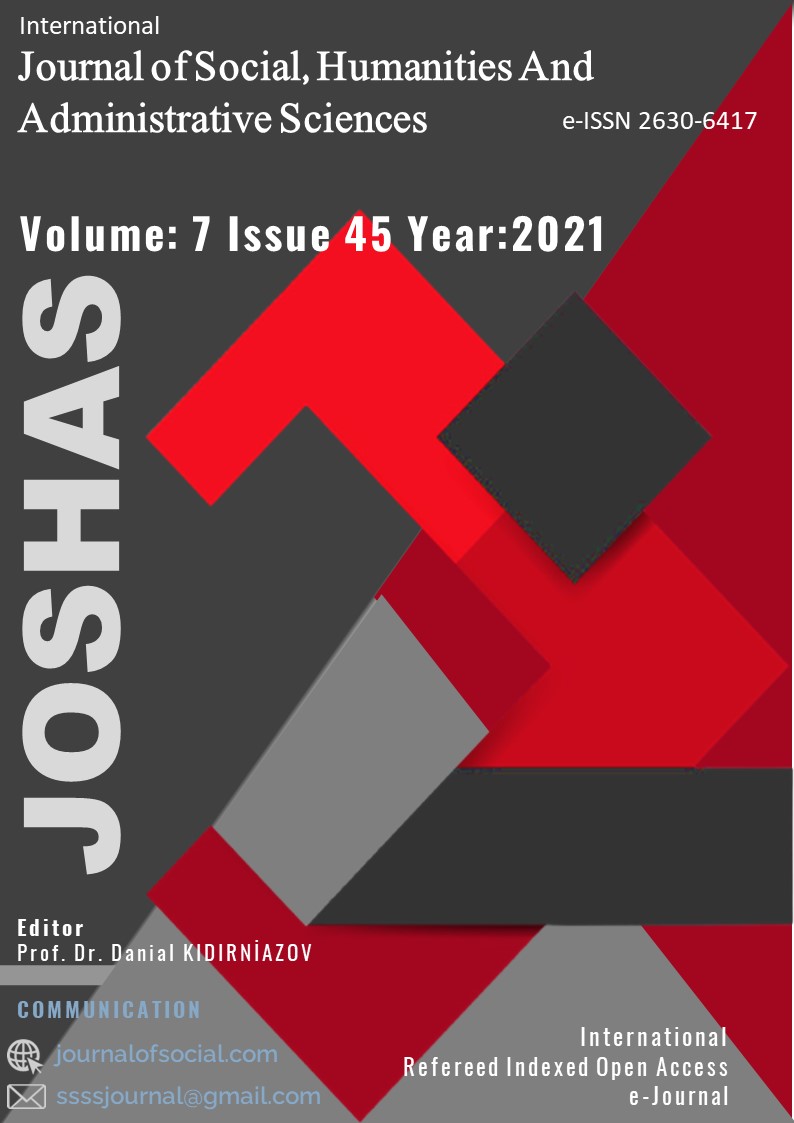Author :
Abstract
İnsanlık tarihi ile birlikte ortaya çıkmış olan sanat, tarihsel süreç içerisinde gelişmiş ve insana özgü olan yeti ile evrilmiştir. Sanat, güzelliğe yani estetik bilimine önem vermiştir. Özne olan sanatçıyı, estetik nesne olan sanat eserini ve alımlayıcı özneyi inceleyen estetik bilimi kavramlar doğrultusunda kendini yenilemiştir. Bu yenilemenin sebebi güzellik kavramının zaman içerisinde değişime uğramasıdır. Çirkinlik içerisinde güzel olanı görme düşüncesinin peşine düşmek estetik bilimine yeni arayışları getirmiş, estetik değerin yeniden biçimlenmesini sağlamıştır. Düşüncenin ve duygunun temel alındığı sanatta, sanatçının yani öznenin yaratıcılığı yaşamı ile bütünlük içerisinde olmuştur. Nesnenin değerleri öznenin nesneye karşı olan tavrını, yaşama ait izlerin özne tarafından yeniden ele alınması ve nesnenin biçimlenmesi öznenin yaratıcılık seviyesini ortaya koymuştur. Birer özne olarak Gustav Klimt ve Egon Schiele yaşama dair birçok şeyi farklı biçim dilleri ile ifade etmiş iki sanatçıdır. Sembolist ressam Gustav Klimt, eserlerinde süslemeyi ön planda tutmuştur. Kadın imgesini güzellik sembolü olarak görmüş ve eserlerinde kadın imgesini kullanarak doğum, ölüm gibi temalara değinmiştir. Gustav Klimt’i ustası olarak görmüş olan ekspresyonist ressam Egon Schiele ise yaşamın olumsuz yanlarını temel almış ve düşüncesini yaşamış olduğu olaylar ile harmanlayıp mutsuz, umutsuz, depresif, hastalıklı figürler ortaya koymuştur. Erotik resimleri ile ahenk yakalamış güzelliği çirkin olanda keşfetmiştir. Gustav Klimt ve Egon Schiele kendi tarzlarında oldukça önemli eserler üretmişlerdir. Üretmiş oldukları yapıtlar izleyiciye kendileri, kendilerinin yaşamı, düşünceleri ve duyguları hakkında bilgi verirken aynı zamanda güzellik kavramını yeniden sorgulatmıştır. Bu çalışmanın amacı Gustav Klimt ve Egon Schiele’nin eserlerini incelemek, öznenin nesneye nesnenin özneye karşı olan tavrı arasındaki ilişkiyi irdelemektir.
Keywords
Abstract
Art, which has emerged with the history of humanity, has developed in the historical process and has evolved with a human-specific ability. Art gave importance to beauty, that is, to the science of aesthetics. The science of aesthetics, which examines the artist as the subject, the work of art as the aesthetic object, and the receptive subject, has renewed itself in line with the concepts. The reason for this renewal is that the concept of beauty has changed over time. Pursuing the idea of seeing the beautiful in ugliness has brought new quests to the science of aesthetics and reshaped the aesthetic value. In art, which is based on thought and emotion, the creativity of the artist, that is, the subject, has been in harmony with his life. The values of the object, the attitude of the subject towards the object, the reconsideration of the traces of life by the subject and the shaping of the object revealed the creativity level of the subject. As subjects, Gustav Klimt and Egon Schiele are two artists who have expressed many things about life in different formal languages. Symbolist painter Gustav Klimt prioritized ornamentation in his works. He saw the image of woman as a symbol of beauty and touched on themes such as birth and death by using the image of woman in his works. Expressionist painter Egon Schiele, who saw Gustav Klimt as his master, took the negative aspects of life as a basis and blended his thoughts with the events he had lived to create unhappy, hopeless, depressed and sickly figures. He discovered beauty in the ugly, harmonizing with his erotic paintings. Gustav Klimt and Egon Schiele produced very important works in their own style. The works they have produced have given the audience information about themselves, their own life, thoughts and feelings, while at the same time making them question the concept of beauty again. The aim of this study is to examine the works of Gustav Klimt and Egon Schiele, to examine the relationship between the subject's attitude to the object and the object to the subject.
Keywords
- Başoğlu, S. (2011). “Art Nouveau ve Gustav Klimt'in Sanatı”, Yüksek Lisans Tezi, Mimar Sinan Güzel
- Başoğlu, S. (2011). “Art Nouveau ve Gustav Klimt'in Sanatı”, Yüksek Lisans Tezi, Mimar Sinan Güzel Sanatlar Üniversitesi Sosyal Bilimler Enstitüsü, İstanbul.
- Bozdemir, İ. (2019). “Avusturyalı İki Dışavurumcu Sanatçı Egon Schiele ve Oskar Kokoschka’nınYapıtlarının Karşılaştırmalı İncelemesi”, Yüksek Lisans Tezi, Dokuz Eylül Üniversitesi Eğitim Bilimleri Enstitüsü, İzmir.
- Egon Schiele: The Leopold Collection, Vienna. (1997). Erişim tarihi: 25.09.2021, https://www.moma.org/artists/5215
- Karaahmetoğlu, A. (2014). “Gustav Klimt’in Sanatı ve Günümüze Yansıması”, Yüksek Lisans Tezi, Işık Üniversitesi Sosyal Bilimler Enstitüsü, İstanbul.
- Krausse, A, C. (2005). Rönesanstan Günümüze Resim Sanatının Öyküsü, Literatür Yayıncılık, İstanbul. Natter, G, T. (2012). Gustav Klimt, Taschen, Köln.
- Renshaw, A. ve Fortenberry, D. (2015). 1898 Art in Vienna, Phaidon London.
- Yüzgüller, S. (2019). Sanatın Büyük Ustaları 11- Klimt, Hayalperest Yayınevi, İstanbul.
- Yüzgüller, S. (2019). Sanatın Büyük Ustaları 12- Egon Schiele, Hayalperest Yayınevi, İstanbul. Görsel Kaynakça
- Görsel 1. Gustav Klimt, “Pallas Athene” 1898, resim boyutu 75×75 cm, çerçeve boyutları 85,3×84,7×5 cm,Tuval üzerine yağlıboya (https://sammlung.wienmuseum.at/en/object/102991-pallas-athene/ Erişim tarihi:Görsel 2. Gustav Klimt, “The Beethoven Frieze: The Hostile Powers. Far Wall” (Beethoven Frizi: DüşmanGüçler. Uzak duvar), 1902, Belvedere, Viyana, Avusturya (https://www.wikiart.org/en/gustav-klimt/the- beethoven-frieze-the-hostile-powers-far-wall-1902-1 Erişim tarihi: 30.09.2021)
- (https://www.wikiart.org/en/gustav-klimt/the-beethoven-frieze-the-longing-for-happiness-left-wall Erişim tarihi: 30.09.2021)
- Görsel 5. Gustav Klimt, “Beethoven Frizi: Mutluluk Özlemi Şiirde Huzur Bulur”, 1902, Belvedere, Viyana,Avusturya (https://www.wikiart.org/en/gustav-klimt/the-beethoven-frieze-the-longing-for-happiness-finds- repose-in-poetry-right-wall-1902-1 Erişim tarihi: 30.09.2021)
- Görsel 12. Egon Schiele, “Two Girls Lying Entwined” (Dolaşmış İki Kız), Kağıt Üzerine Suluboya, 1915,Albertina Müzesi, Viyana, Avusturya (https://www.wikiart.org/en/egon-schiele/two-girls-lying-entwined- 1915 Erişim tarihi: 03.09.2021)





